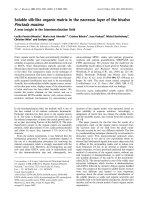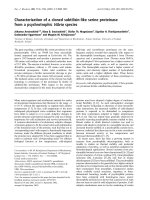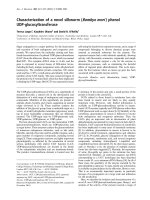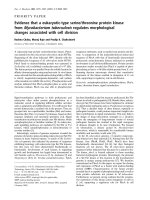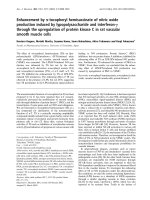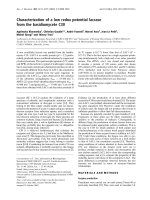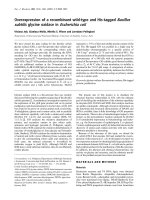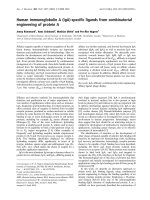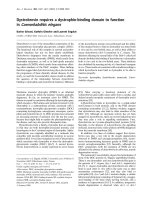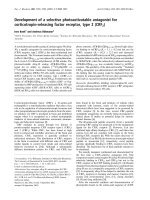Báo cáo y học: "Soluble RAGE: a hot new biomarker for the hot joint" pdf
Bạn đang xem bản rút gọn của tài liệu. Xem và tải ngay bản đầy đủ của tài liệu tại đây (41.21 KB, 3 trang )
142
NID = non-inflammatory diseases of the joints; RA = rheumatoid arthritis; RAGE = receptor for advanced glycation endproducts; sRAGE = soluble
RAGE.
Arthritis Research & Therapy August 2005 Vol 7 No 4 Moser et al.
Abstract
The receptor for advanced glycation endproducts (RAGE)
interacts with distinct ligand families linked to the inflammatory
response. Studies in animal models suggest that RAGE is
upregulated in the inflamed joint and that blockade of the receptor,
using a ligand decoy soluble form of RAGE (sRAGE), attenuates
joint inflammation and expression of inflammatory and tissue-
destructive mediators. In this issue of Arthritis Research & Therapy,
Rille Pullerits and colleagues reported that plasma levels of sRAGE
were reduced in subjects with rheumatoid arthritis compared with
healthy controls or subjects with non-inflammatory joint disease.
These findings suggest the possibility that levels of sRAGE might
be a biomarker of inflammation. Not resolved by these studies,
however, is the intriguing possibility that endogenously higher
levels of sRAGE might be linked to a lower incidence of arthritis or
to the extent of inflammation. Nevertheless, although ‘cause or
effect’ relationships may not be established in this report,
fascinating insights into RAGE, inflammation and human arthritis
emerge from these studies.
Introduction
In this issue of Arthritis Research & Therapy, Pullerits and
colleagues [1] reported that plasma levels of soluble receptor
for advanced glycation endproducts (sRAGE) were
decreased in human subjects with rheumatoid arthritis (RA)
compared to healthy normal subjects or subjects with non-
inflammatory diseases of the joints (NID). Although no
significant differences were observed between levels of
synovial sRAGE in subjects with RA and NID, synovial
sRAGE levels significantly distinguished those RA subjects
treated with disease-modifying anti-rheumatic drugs
(DMARDs) from those not on these treatments. Subjects with
RA receiving methotrexate displayed significantly higher
levels of synovial sRAGE [1]. These fascinating findings,
based on a single observation point in each subject, prompt
us to consider whether sRAGE’s role is cause and/or effect
in disease/disease activity in the RA joint.
In this context, full interpretation of these findings will require
comprehensive answers to the questions such as the
following: Do plasma sRAGE levels vary from day to day in a
subject? Do they vary over the lifespan of the individual?
What were the levels of sRAGE in the RA subjects before the
onset of disease manifestation? What other environmental or
genetic factors might influence levels of sRAGE in the
individual subject? Despite these caveats, a key lesson in
these studies is that levels of sRAGE, at least in the synovial
fluid, might be modified by intense anti-inflammatory therapy.
Indeed, an emerging theme in the biology of RAGE links this
receptor to proinflammatory mechanisms. At least four
classes of inflammatory ligands, namely S100/calgranulins,
amphoterin (also known as high mobility group box I or
HMGB1), Mac-1, and advanced glycation endproducts
(AGEs), are signal transduction ligands of RAGE [2-5].
Intriguingly, these ligand families are upregulated in the
serum, the synovium or the fluid bathing the arthritic joint. In
certain cases, levels of S100/calgranulins and amphoterin,
for example, reflect the extent of disease activity [6-9]. Such
findings still do not resolve a key issue: is the modulation of
plasma sRAGE levels cause or effect? In this context, studies
in animal models have provided insights into mechanisms by
which RAGE might be linked to proinflammatory mechanisms.
RAGE, inflammation and arthritis: insights
from animal models
Experimental findings support the premise that the biology of
RAGE extends beyond diabetes [10]. For example, studies in
euglycemic mouse models of delayed-type hypersensitivity
and colitis in interleukin-10-null mice suggested that a
blockade of RAGE attenuated inflammation and the
upregulation of cytokines and transcription factors such as
NF-κB [2]. In the specific context of arthritis, administration of
soluble RAGE to mice with collagen-induced arthritis
attenuated clinical scores of joint inflammation, in parallel with
Commentary
Soluble RAGE: a hot new biomarker for the hot joint?
Bernhard Moser, Barry I Hudson and Ann Marie Schmidt
Department of Surgery, College of Physicians and Surgeons, Columbia University, New York, NY, USA
Corresponding author: Ann Marie Schmidt,
Published: 3 June 2005 Arthritis Research & Therapy 2005, 7:142-144 (DOI 10.1186/ar1764)
This article is online at />© 2005 BioMed Central Ltd
See related research by Pullerits et al., />143
Available online />decreased joint expression of cytokines and antigen/activity
of matrix metalloproteinases [11]. In other studies, evidence
strongly supporting roles for RAGE ligands in the develop-
ment of collagen-induced arthritis in mice was demonstrated
by a reduced arthritis score and the histological severity of
arthritis in animals treated with polyclonal antibodies against
amphoterin (HMGB1) [12].
These experiments strongly suggested that augmenting levels
of sRAGE was beneficial. Indeed, in the human model,
administration of methotrexate resulted in significantly
enhanced levels of soluble RAGE in synovial fluid, with a
trend toward increased levels in plasma [1]. Presumably, in
those subjects, levels of sRAGE rose in parallel with decreased
inflammation. It remains unclear whether methotrexate-
induced suppression of inflammation facilitated the generation/
stability of endogenous sRAGE and, thus, ligand-trapping
and reduced inflammation. Alternatively, did inflammation
ensue directly as a consequence of endogenously low
sRAGE levels – levels that were somehow modulated by
administration of methotrexate? Clearly, long-term prospec-
tive studies of measurement of plasma/synovial sRAGE in RA
subjects are needed. Is it possible that patterns of sRAGE
expression might help to identify subjects in whom
aggressive therapy may be indicated [13]?
These intriguing studies have striking parallels in the work of
Falcone and colleagues [14]. These investigators studied non-
diabetic men with or without coronary artery disease. They
found that the lowest levels of plasma sRAGE in these subjects
correlated with the highest incidence of coronary artery
disease. These studies, as in those of Pullerits and colleagues,
suggest that endogenously low levels of sRAGE might be
either a biomarker of inflammation and/or part of the problem.
How may this be settled? An important piece of this puzzle is
solved when the cellular source(s) of sRAGE are delineated.
What are the source(s) of plasma and
synovial sRAGE?
RAGE is expressed by multiple cell types, including vascular
and inflammatory cells – the latter including neutrophils,
mononuclear phagocytes and lymphocytes – and by synovial
cells [11]. The studies reported by Pullerits and colleagues
do not delineate the cellular sources of sRAGE measured in
the plasma and synovial fluid. In addition, the specific
mechanism by which sRAGE is generated remains unclear.
Further, does the species recognized by the commercially
available polyclonal and monoclonal antibodies employed by
Pullerits and colleagues reflect soluble RAGE perhaps
cleaved from the cell surface receptor? Alternatively, does
this assay recognize novel soluble splice variants of the
receptor [15-17]? The antibodies against RAGE employed in
the ELISA used by Pullerits and colleagues do not distinguish
between these two possible sources. Future studies must
investigate precisely which sources and species of sRAGE
are relevant to inflammatory arthritis.
Genetic variants, RAGE and RA
Previous studies suggested interesting links between RAGE
and human arthritis [11,18]. It has previously been shown that
a polymorphism of the gene encoding RAGE located within
the V-type immunoglobulin domain of RAGE, which results in
a glycine to serine substitution at amino acid position 82, is in
linkage disequilibrium with HLA-DR4 [18]. It was therefore
not surprising that the Ser82 allele was increased in RA
subjects [11]; what remains to be studied is whether the
variant is associated with disease activity. In that context, the
V-type immunoglobulin domain of RAGE is the site of ligand
binding. Thus, not surprisingly, studies in cell culture models
suggested that the protein product of the Ser82 isoform
displayed increased affinity for RAGE ligands versus that
observed with the wild type (Gly82) form [11]. It also remains
to be determined whether these variants relate to the
regulation of sRAGE in plasma or synovial fluid.
Perspectives
The work of Pullerits and colleagues adds to the growing
body of human data on RAGE, sRAGE, genetic variants and
inflammation. These investigators placed sRAGE for the first
time in synovial fluid and indicate that its levels might be
modulated by intense anti-inflammatory therapy. Although
‘cause or effect’ may not be elucidated from these
experiments, prospective studies in RA and other
inflammatory disorders should be undertaken to delineate
whether sRAGE levels are a reproducible and predictive
biomarker for the extent of inflammatory arthritis and/or the
response to disease-modifying/anti-inflammatory therapy.
Competing interests
AMS is a member of the scientific advisory board of, and
receives research support from, TransTech Pharma, Inc.
Acknowledgements
This work was supported by grants from the USPHS and the Juvenile
Diabetes Research Foundation International. BIH is a recipient of a
postdoctoral fellowship from the Juvenile Diabetes Research Founda-
tion International. AMS is a recipient of a Burroughs Wellcome Fund
Clinical Scientist Award in Translational Research.
References
1. Pillerits R, Bokarewa M, Dahlberg L, Tarkowski A: Decreased
levels of soluble receptor for advanced glycation endproducts
in patients with rheumatoid arthritis indicating deficient
inflammatory control. Arthritis Res Ther 2005, 7:R817-R824.
2. Hofmann MA, Drury S, Fu C, Qu W, Taguchi A, Lu Y, Avila C,
Kambham N, Bierhaus A, Nawroth P, et al.: RAGE mediates a
novel proinflammatory axis: a central cell surface receptor for
S100/calgranulin polypeptides. Cell 1999, 97:889-901.
3. Taguchi A, Blood DC, del Toro G, Canet A, Lee DC, Qu W, Tanji
N, Lu Y, Lalla E, Fu C, et al.: Blockade of amphoterin/RAGE sig-
nalling suppresses tumour growth and metastases. Nature
2000, 405:354-360.
4. Chavakis T, Bierhaus A, Al-Fakhri N, Schneider D, Witte S, Linn T,
Nagashima M, Morser J, Arnold B, Preissner KT, et al.: The
Pattern Recognition Receptor (RAGE) is a counterreceptor for
leukocyte integrins: a novel pathway for inflammatory cell
recruitment. J Exp Med 2003, 198:1507-1515.
5. Schmidt AM, Vianna M, Gerlach M, Brett J, Ryan J, Kao J, Espos-
ito C, Hegarty H, Hurley W, Clauss M, et al.: Isolation and char-
acterization of binding proteins for advanced glycosylation
144
Arthritis Research & Therapy August 2005 Vol 7 No 4 Moser et al.
endproducts from lung tissue which are present on the
endothelial cell surface. J Biol Chem 1992, 267:14987-14997.
6. Kokkola R, Sundberg E, Ulfgren AK, Palmblad K, Li J, Wang H,
Ulloa L, Yang H, Yan XJ, Furie R, et al.: High mobility group box
chromosomal protein 1; a novel proinflammatory mediator in
synovitis. Arthritis Rheum 2002, 46:2598-2603.
7. Andersson U, Erlandsson-Harris H: HMBG1 is a potent trigger
of arthritis. J Intern Med 2004, 255:344-350.
8. Foell D, Wittkowski H, Hammerschmidt I, Wulffraat N, Schmeling
H, Frosch M, Horneff G, Kuis W, Sorg C, Roth J: Monitoring neu-
trophil activation in juvenile rheumatoid arthritis by S100A12
serum concentrations. Arthritis Rheum 2004, 50:1286-1295.
9. Youssef P, Roth J, Frosch M, Costello P, Fitzgerald O, Sorg C,
Bresnihan B: Expression of myeloid related proteins (MRP) 8
and 14 and the MRP 8/14 heterodimer in rheumatoid arthritis
synovial membrane. J Rheumatol 1999, 26:2523-2528.
10. Yan SF, Ramasamy R, Naka Y, Schmidt AM: Glycation, inflam-
mation and RAGE: a scaffold for the macrovascular complica-
tions of diabetes and beyond. Circ Res 2003, 93:1159-1169.
11. Hofmann MA, Drury S, Hudson BI, Gleason MR, Qu W, Lu Y,
Lalla E, Chitnis S, Monteiro J, Stickland MH, et al.: RAGE and
arthritis: the G82S polymorphism amplifies the inflammatory
response. Genes Immunity 2002, 3:123-135.
12. Kokkola R, Li J, Sundberg E, Aveberger AC, Palmblad K, Yang H,
Tracey KJ, Andersson U, Harris HE: Successful targeting of col-
lagen-induced arthritis in mice and rats by targeting extracel-
lular high mobility group box chromosomal protein 1 activity.
Arthritis Rheum 2003, 48:2052-2058.
13. Combe B: Should patients with recent-onset polyarthritis
receive aggressive treatment? Joint Bone Spine 2004, 71:475-
480.
14. Falcone C, Emanuele E, D’Angelo A, Buzzi MP, Belvito C, Cuccia
M, Geroldi D: Plasma levels of soluble receptor for Advanced
Glycation Endproducts and coronary artery disease in nondia-
betic men. Arterioscler Thromb Vasc Biol 2005, 25:1032-1037.
15. Yonekura H, Yamamoto Y, Sakurai S, Petrova RG, Abedin MJ, Li
H, Yasui K, Takeuchi M, Makita Z, Takasawa S, et al.: Novel
splice variants of the receptor for advanced glycation end-
products expressed in human vascular endothelial cells and
pericytes, and their putative roles in diabetes-induced vascu-
lar injury. Biochem J 2003, 370:1097-1109.
16. Schlueter C, Hauke S, Flohr AM, Rogalla P, Bullerdiek J: Tissue
specific expression patterns of RAGE receptor and its soluble
forms – a result of regulated alternative splicing? Biochim
Biophys Acta 2003, 1630:1-6.
17. Park IH, Yeon SI, Youn JH, Choi JE, Sasaki N, Choi IH, Shin JS:
Expression of a novel secreted splice variant of the receptor
for advanced glycation endproducts (RAGE) in human brain
astrocytes and peripheral blood mononuclear cells. Mol
Immunol 2004, 40:1203-1211.
18. Prevost G, Fajardy I, Fontaine P, Danze PM, Besmond C: Human
RAGE GLY82SER dimorphism and HLA class II DRB1-DQA1-
DQB1 haplotypes in type 1 diabetes. Eur J Immunogenet 1999,
26:343-348.
